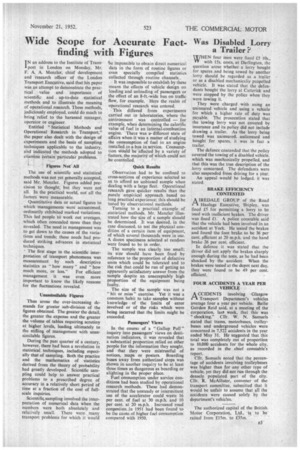Wide Scope for Accurate Fact
Page 37

If you've noticed an error in this article please click here to report it so we can fix it.
finding with Figures
IN an address to the Institute of TransI port in London on Monday, Mr. F. A. A. Menzler, chief development and research officer of the London Transport Executive, said that his paper was an attempt to demonstrate the practical value and importance of scientific and up-to-date statistical methods and to illustrate the meaning of operational research. These methods, judiciously employed, could do much to bring relief to the harassed manager, operator or engineer.
Entitled "Statistical Methods and Operational Research in Transport," the paper also dealt with the design of experiments and the basis of sampling techniques applicable to the industry, and indicated the methods adopted to examine Certain particular problems.
Figures Not AU The Use of scientific and statistical methods was not yet generally accepted, said Mr. Menzler. Figures added precision to thought, but they were not all. In the practical world, not all the factors were measurable.
Quantitative data or actual figures to which managements were accustomed, ordinarily exhibited marked variations. This led people to work out averages, which often concealed more than they revealed. The need in management was to get down to the causes of the variations and trends; these needs had produced striking advances in statistical techniques.
• The first stage in the scientific interpretation of transport phenomena was measurement by such descriptive statistics as '' how many and "how much more, or less." For efficient management it was even more important to know the likely reasons for the fluctuations revealed.
Unussimilable Figures Thus arose the ever-increasing demands for greater sub-division of the figures obtained. The greater the detail, the greater the expense and the greater the volume of tables requiring scrutiny at higher levels, leading ultimately to the stifling of management with unassimilable figures,
During the past quarter of a century, however, there had been a revolution in statistical techniques, including especially that of sampling. Both the practice and the mathematics of statistics derived from the theory of probability had greatly developed. Scientific sampling could help to answer practical problems to a prescribed degree of accuracy in a relatively short period of time at a fraction of the cost of fullscale inquiries.
Scientificesampling involved the interpretation of numerical data when the numbers were both absolutely and relatively small. There were many transport problems for which it would 'he impossible to obtain direct numerical data in the form of routine figures or even specially compiled statistics collected through routine channels.
It was impossible to establish by these means the effects of vehicle design on loading and unloading of passengers or the effect of an 8-ft.-wide bus on traffic flow, for example. Here the realm of operational research was entered.
This differed from experiments carried out in laboratories, where the environment was controlled — for example, when determining the calorific value of fuel in an internal-combustion engine. There was adifferent state of affairs when it was a matter of studying the consumption of fuel in an engine installed in a bus in service. Consumption would be affected by a variety of faotors, the majority of which could not be controlled. • Quick Results Observation had to be confined to cross-sections of experience selected so as to afford an unbiased sample when dealing with a large fleet. Operational research gave quicker results than the purely • empirical approach based on long practical experience; this should be tested by observational methods.
Turning to a practical example of statistical methods, Mr. Menzler illustrated how the size of a sample should be determined. It was desired, in the case discussed, to test the physical condition of a certain item of equipment, of which several thousands were in use. A dozen specimens selected at random were found to be in order.
The sample was clearly too small: its size should have been fixed by reference to the proportion of defective units which could be tolerated and to the risk that could be run of getting an apparently satisfactory answer from the sample despite an unacceptably high proportion of the equipment being faulty.
The size of the sample was not a "hit or miss" exercise. Yet it was a common habit to take samples without knowledge of the limits of error involved or of the risks which were being incurred that the limits might be exceeded.
Passengers' Views
In the course of a "Gallup Poll" inquiry into passengers' views on destination indicators, it was revealed that a substantial proportion relied on other people for the information they sought, and that they were mistrustful of notices, maps or posters. Boarding buses away from authorized stops was shown in another inquiry to be at least three times as dangerous as boarding or alighting in the proper place.
Fuel consumption under service conditions had been studied by operational research methods. These had demonstrated that the unsteady or intermittent use of the accelerator could waste 16 per cent. of fuel at 30 m.p.h. and 10 per cent. at 20 m.p.h. Increased road congestion in 1951 had been found to he the cause of higher fuel consumption compared with 1950.




















































































